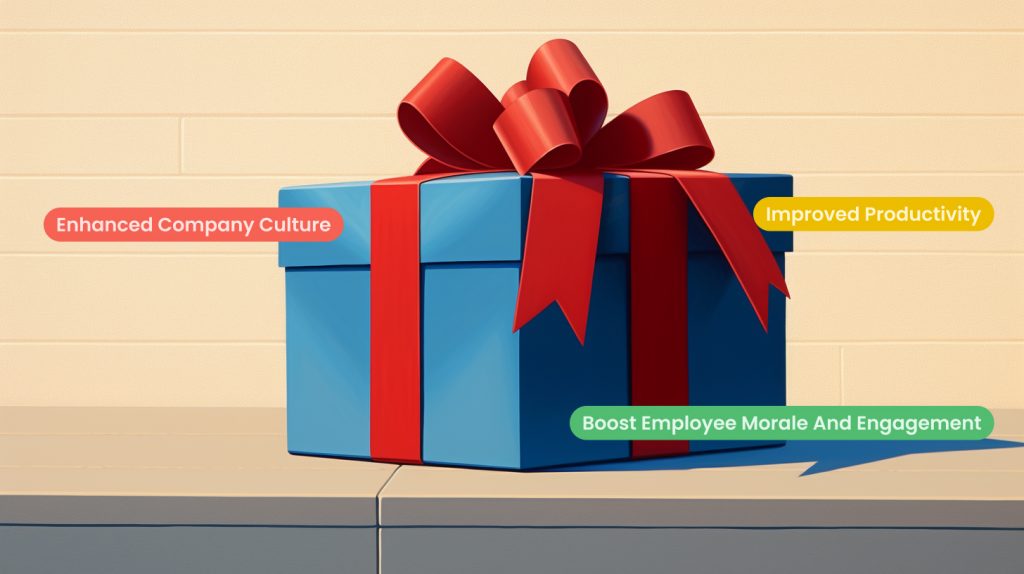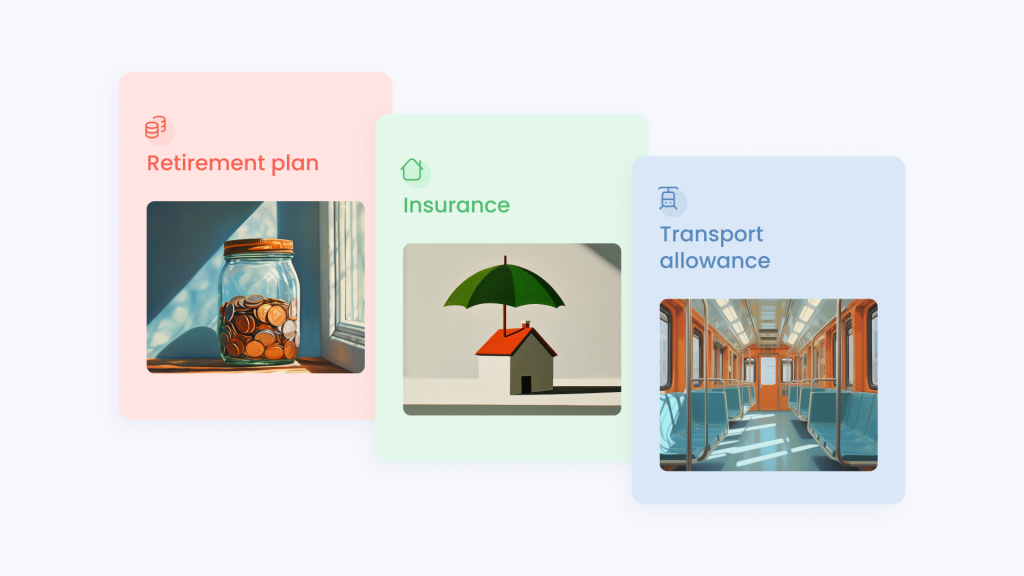A compensation system goes beyond just salaries and wages. Providing additional benefits is considered best practice as it can enhance employee satisfaction, motivation, and employee retention. One such category of benefits is de minimis fringe benefits, which are small perks provided to employees that are exempt from taxation due to their minimal value.
This article provides Philippine employers with all the essential information about de minimis fringe benefits, including their advantages, tax implications, and examples of common perks.
What are de minimis fringe benefits?
De minimis fringe benefits are a form of employee perks that are tax-free and provided by Philippine employers as a way to support the welfare of their employees.
They are provided on an occasional basis and held in little value that it would be difficult to track and tax these benefits.
Employers are not legally mandated to provide these non-taxable benefits. It can be done on a voluntary basis as a way to drive employee performance and boost engagement in the workplace.
However, the Bureau of Inland Revenue (BIR) has outlined various laws and regulations that must be followed for employers who choose to support their workforce with these benefits.
The legal basis for de minimis benefits in the Philippines can be found in section 33 [c] of the National Internal Revenue Code (NIRC).
It is important for employers to navigate these laws carefully to ensure compliance and mitigate potential lawsuits.
Examples of de minimis benefits include movie tickets, catered lunches, break room snacks, t-shirts, coffee cups, and similar items.
Relevant reading: The Employer’s Guide to Labor Codes in the Philippines
What is the difference between fringe benefits and de minimis fringe benefits?
Fringe benefits are quite similar to de minimis benefits except that fringe benefits typically provide substantial and tangible value to employees and are often subject to taxation, whereas de minimis fringe benefits are minimal in value, provided infrequently, and are usually exempt from taxation due to their insignificant value.
Fringe benefits are taxed at a 35% rate while de minimis benefits remain tax-free as long as it doesn’t exceed the limits prescribed by BIR.
Examples of fringe benefits included in an employees benefits package include retirement plans, employee stock options, health insurance, child care assistance, wellness programs, etc.
Read next: HR’s Guide to Fringe Benefits
What are the examples of de minimis fringe benefits?

Under the Revenue Regulations No. 11-2018, the BIR has outlined 11 types of non taxable de minimis fringe benefits:
- Monetized unused vacation leave that doesn’t exceed 10 during the year for private employees.
- Monetized unused vacation and sick leaves for government officials and employees.
- Generous employer giving medical cash allowance to dependent employees that doesn’t exceed ₱ 1,500 per semester or ₱ 250 per month.
- Rice subsidy of ₱ 2,00 or one sack of 50kg rice amounting to not more than ₱ 2,000 per month.
- Uniform and clothing allowance not exceeding ₱ 6,000 per month.
- In case an unfortunate event happens, the actual medical assistance provided by the employer not exceeding ₱ 10,000 is considered to be de minimis as well.
- Laundry allowance that doesn’t exceed ₱ 300 per month is also part of de minimis fringe benefits.
- If you are an outstanding employee who receives an award and non-cash tangible personal property valued at less than ₱ 10,000, you will enjoy tax-free benefits.
- Gifts given during Christmas and major anniversary celebrations not exceeding ₱ 5,000 per employee per annum.
- Another non taxable de minimis fringe benefits would be daily meal allowances for employees who work overtime or in a graveyard shift. The allowance shouldn’t exceed 25% of the basic minimum wage on a per region basis.
- Benefits received by an employee under a collective bargaining agreement (CBA) and productivity incentive schemes combined not exceeding ₱ 10,000 per employee per taxable year is also a part of the non-taxable compensation.
It is important to note that all other benefits not listed above shall not be considered as de minimis benefits and therefore are subject to income tax and withholding tax on compensation income.
What benefits are not considered de minimis fringe benefits?
In the Philippines, benefits that do not qualify as de minimis fringe benefits typically include those that exceed specified limits or do not fall within the categories defined by the Bureau of Internal Revenue. Here are some benefits that are generally not considered de minimis fringe benefits:
- De minimis fringe benefits are subject to specific monetary limits set by the BIR. If cash allowances for medical, rice subsidy, or uniform/clothing exceed these limits, they are no longer considered minimal in value and therefore do not qualify as de minimis fringe benefits.
- Transportation assistance such as the use of company cars that doesn’t also exceed the de minimis threshold.
- Free membership in clubs or gyms that doesn’t exceed its de minimis limits.
- Regular bonuses, performance incentives, and other significant monetary rewards are not de minimis.
- Tuition fees or substantial educational allowance involve significant financial support. These benefits are considerable in value and often ongoing, which makes them ineligible as de minimis fringe benefits.
- Gifts, prizes or awards of substantial value are also not considered as de minimis fringe benefits.
- Housing and regular transportation allowance are provided on a frequent basis and have substantial value. This disqualifies them from being de minimis.
- Bonuses and performance incentives are typically substantial in amount and intended as significant rewards for employee performance. They are not considered minor or infrequent and thus do not meet the criteria for de minimis benefits.
What are the tax implications of de minimis fringe benefits?
In the Philippines, the tax implications of de minimis fringe benefits are governed by the Bureau of Internal Revenue regulations. Here’s how they are treated:
For employees
De minimis benefits are not subject to federal taxes, therefore employees don’t have to include them as part of their taxable income. There is also no filing process required as these benefits are automatically exempt from taxation due to their minimal value and infrequent nature. This means that employees receive these small perks without any additional tax burden or the need to report them separately on their tax returns, simplifying their financial and tax management.
Additional reading: Preparing for ITR Philippines
For employers
Employers typically need to withhold income taxes from employees’ wages and report these amounts to the tax authorities. However, because de minimis fringe benefits are exempt from taxation, employers do not need to withhold any income taxes on these specific benefits. This simplifies the payroll process and reduces administrative burden associated with employee compensation.
They must ensure that the benefits provided comply with BIR Revenue Regulations No. 3-98 and any subsequent amendments. These regulations specify the types and limits of de minimis benefits that qualify for tax exemption.
Also for compliance purposes, employers should maintain accurate records of all de minimis benefits provided.
Overall, de minimis fringe benefits offer tax advantages for both employees and employers, making them an attractive option for providing employee perks.
Learn more: HR’s Guide to Payroll Taxes in the Philippines
What are the advantages of offering de minimis fringe benefits?

Here are the various ways employees and employers can be impacted by de minimis fringe benefits:
For employees
Boost employee morale and engagement
Employees are happier and more engaged with their work when they receive small perks. These de minimis benefits, such as free coffee, small holiday gifts, occasional free meals, or recognition awards, make employees feel appreciated and valued.
Enhanced company culture
De minimis benefits help create a positive and supportive work environment, making employees feel more connected and valued. The care and attention received from employers help build a sense of community and belonging among employees.
Improved productivity
Offering de minimis benefits can be used as a tool to facilitate employee performance and productivity. With highly motivated and productive employees, companies can achieve their goals more efficiently. For example, when an employee receives a monthly medical allowance of ₱ 250, it not only helps them manage minor health expenses but also demonstrates that the company cares about their well-being. This appreciation translates into higher morale and motivation, leading to increased efficiency and focus on their tasks. As a result, the overall productivity of the company improves, enabling it to meet deadlines, enhance customer satisfaction, and ultimately achieve its business objectives more effectively.
For employers
Cost effective way to reward employees
Small businesses or startups on a tight budget that are looking for a low-cost yet impactful way to reward their employees should consider de minimis benefits as part of their benefits package.
This is because these benefits are of minimal financial value, making them relatively inconsequential to both the employer and the employee. The cost of providing and accounting for them is often negligible.
Attract and retain top talent
De minimis as a form of additional perks can become a part of a company’s offerings which makes it more attractive to potential hires.
Employees can increase job satisfaction and retain current employees by customizing their de minimis benefits package to fit their preferences and needs. For example, offering options such as a monthly rice subsidy, small holiday gifts, occasional free meals, or transportation reimbursements can make employees feel valued and cared for.
Tailoring these benefits to individual preferences not only shows that the company is attentive to their needs but also enhances their overall work experience, leading to increased loyalty.
Read next: 24 Creative New Employee Welcome Kit Ideas
Reduced absenteeism
Absenteeism has a significant impact on the Philippines workforce, with companies often facing decreased productivity and increased operational costs.
A way for employers to address this issue is by offering support to their employees through small perks such as free snacks, occasional paid time off for personal errands, or small wellness benefits.
Employees who feel valued and appreciated are more likely to have higher attendance and lower absenteeism rates. This contributes to a productive and consistent work environment.
Unlock the Power of Benefits with Omni
Employee engagement affects every aspect of your organization, from culture to morale, productivity to innovation, investing in your employees by providing de minimis fringe benefits is a sure fire way to improve your business functions and drive growth.
It is clear that de minimis benefits enable businesses to attract, recruit, motivate and retain highly skilled employees. It also results in increased employee satisfaction and loyalty, thereby reducing attrition rates. Omni gives you the tools and resources you need to build a well-organized, engaged workforce and effectively implement your fringe benefits programs.
Omni streamlines not just your de minimis fringe benefits efforts but also automates time-consuming and repetitive tasks, and frees up your valuable time and energy so you can focus on what really matters — strategically engaging and nurturing your team.
Omni’s time off management capabilities help managers and HR teams swiftly navigate employee leave management. Omni’s platform allows you to approve leave applications on the go and keep track of who’s in and out of the office with at-a-glance scheduling.
Our employee self-service portal empowers employees to submit their time off requests, which automatically routes to the appropriate manager thanks to customizable approval workflows. With automated calculations, employees and managers can easily view leave balances in real-time, and track how many vacation days they have left without having to go through HR.
Want to boost employee engagement? Download our free HR Calendar 2024 for more inspiration!




